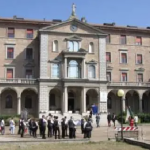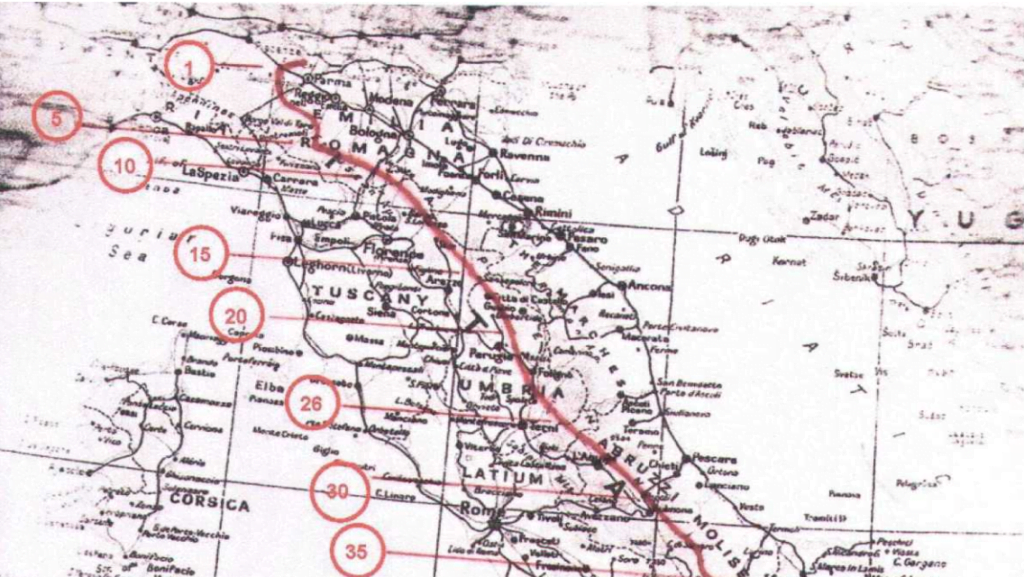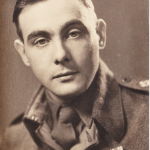Summary of Peter Jordan
This factual story, recounted by Peter’s son, highlights his father’s time in PG47 Modena and later in Fontanellato. The similarities of his father’s stories with those recounted by Eric Newby are highlighted by the author. Peter headed South after his escape and was within earshot of the Allied lines when he was captured and sent to Oflag V111F and later to Oflag 79. Capt Michael Goldingham was in the same camp.
The full story follows, in two versions. The version in the first window below is the original scanned version of the story. In the second window below is the transcribed version in plain text.
[Digital page 1]
ARMY Service of Lieutenant F P Jordan (Peter)
Service Nr 220630
50th Btn Recon Corps (Northumberland Fusiliers)
Over the years, I have gleaned partial insights into my father’s war experiences. It started in my teens when, late at night, returning from his visit to the pub, he would recount episodes from his war. These reminiscences were, generally, garbled, often repeated and seldom conclusive. I do, however remember specific stories which I would later piece together with information from other sources. His most graphic memories where of his incarceration in a POW Camp in Italy between 1942 and 1943. In particular, he told of a grand building next to a convent with several floors; he remembers it as some sort of a hospital before the war and recounts tales of nuns (in Newby’s book these were local girls, not nuns) being whistled at and cheered by POWs as they, dressed in habits, walked in line past the camp. Several years later I read ‘Love and War in the Apennines’ by Eric Newby; I think I found it in my father’s possessions after he died in 1986. Many of the episodes in Eric’s book mirrored those late-night stories I remembered from my father.
But to begin at the beginning. Prior to the war, my father, a keen horseman, had joined the North Somerset Yeomanry, part of what became the Territorial Army, the TA. When war broke out, he was, I’m told, a Company Sgt Maj… allegedly the youngest in the then British Army. I remember him telling me that he was a Troop Sergeant with a horse called White Socks. At the age of 25 he was embarked with his troop to Aquir near Ramleh in Palestine. The NSY took over a former RAF Base and here he remained, apart from 2 weeks in mid-June ’41 where he was credited with the Syrian Campaign,(likely this was the Battle for Damascus where Indian, Australian and British troops supported the Free French in taking Damasus) until late 1941 when his Troop was disbanded (this is a guess… in fact the North Som Yeomanry was not disbanded until the following spring so whether he was sent to OCTU as part of the rationalization or because he was chosen for Officer Training is unclear. The base in Aquir was returned to the RAF in early ’42 at which time it became the home of Nr 2 Middle East Training Section under the command of WinCo Donald Benbow DFC who was to become my father’s brother in law. I have a memory that a mention was made somewhere that Donald had seen some mention of his OB friend on the base. They in fact had met in Cairo or Alexandria when Dad was at OCTU). He was then sent to OCTU in Egypt where he gained his Commission on 19th Oct ’41. In early Nov ’41 he served as 2nd Lieut, 50th Btn, Reconnaissance Corp (part of the Long Range Desert Group made famous as the Desert Rats) back in Palestine. He was then posted to the Western Desert (Egypt) from 22 Nov until 10th Jan ’42 before being sent back to Palestine and Syria until the end Feb ’42. He was then back in the Western Desert (Egypt) until his capture on 6th June ’42. This period relates to the British Army’s simultaneous defense of
[Digtial page 2]
Palestine and Rommel’s attack on the western borders of Egypt in the Spring of ’42. In the June of that year, in the Battle of Gazala, the Germans, assisted by the Italians, attacked the southern flank of the Allies in the Cauldron, taking them by surprise and pushing the Allies back into Egypt. Dad was captured in this battle at Bir Hacheim as the commander of a Daimler Scout car. These vehicles had pre-select gears which drivers kept pre-selected in reverse, making a hasty retreat once the enemy was sighted by ‘dabbing’ the clutch. Whether this played a part in his capture is unclear. Dad told me that it was his senior officers under Major General Ritchie that were to blame for the fiasco that resulted in overrunning of the XIII Army including the 50th Btn by Rommel’s forces. This was also the conclusion of John Bierman and Colin Smith in their account pages 168 to 172 of Alamein, War Without Hate. It proved, however, to be the turning point of the war as it resulted in the replacement of General Auckinleck by Montgomery and the subsequent Battle of El Alamein.
He may have been held in holding camps prior to transport to Italy. After being shipped across the Mediterranean from North Africa to Italy during the late summer of ’42 he finally ended up in Oct ’42 in PG47, Modena where he was kept until April ’43. PG47 was a Field camp holding some 1000 prisoners, mostly South Africa airmen but some NZ and English Officers. Thereafter, the dates of his time as a POW are easier to reconcile. By March the following year PG47 held some 1248 prisoners, mostly South African, so some POWs, including Dad, were moved 80 kms west to PG 49, which had been opened in March ’43. PG 49 in Fontanellato, near Parma was a unique prison camp in that it was an imposing stone building in the town, built as an orphanage in the early ‘30s and put to use as a Prisoner of War camp housing some 600 inmates. It was from this camp in April that Dad was able to send a postcard to his sister Mary’s husband, Alan Scoones. By all accounts, this was one of the better POW Camps and camp life is recounted in Eric Newby’s book ‘Love and War in the Apennines’. Several of the episodes in that book tallied with stories told by my father in late evenings in the ‘60s, including the guards shooting at the POWs as they gathered at the windows to whistle at the local girls walking up the street past the orphanage and the breaking of Eric Newby’s ankle on the stairs just before the Mass Breakout. He escaped at the time of the Italian Armistice (9th Sept ’43) … the Italian Commander of the camp allowed the release of the prisoners the day before the arrival of the Germans, for which he paid dearly (see ‘Bugle Call to Freedom’ by Marco Minardi). In other camps, under instruction from the War Office, Senior Officers ordered men to ‘stay put and wait for the allied troops’ at this time stalled in the south. Some of the 600 escapees headed south in an attempt to join the Allies, among them William (Jack) Clarke. It is likely from his recollections that he followed much the same path as my father. Others, such as Eric Newby, joined local groups in the resistance and a few headed North to Switzerland. There are several accounts of these escapees and these are well documented. Many, including my father, headed south in small groups. Trying to cross difficult terrain in occupied territory must have been
[Digital page 3]
exceedingly difficult and many did not make it. Dad tells of living off chestnuts during this long hike of over 800 kms only to come up against the rear of the German Army holding the Allies at bay. He is reported as saying that he was within earshot of Allied guns when recaptured on the 26th October, some 6 weeks later, by German Paratroopers. By this time the Allies had landed at Salerno on September 3rd-17th, although they were being fiercely contested by German Forces. He and many of the other Allied POWs were then sent to German Occupied territories in the north. This trip, in cattle trucks during the early winter, across the Alps must have been difficult and traumatic.
NOTE: I have an acquaintance here in Qala, whose sister Katty Kay, is married to Tom Carver, they are journalists. Tom’s father, Richard, was the stepson of Monty (see above) and was captured in Oct ’42 in the Western Desert before Rommel’s final defeat. He was sent to Italy and also landed up in PG 49 Fontanellato with Dad. At the time of the Armistice, he went South to try and link up with the allies. Unlike Dad he managed to get through the German lines and found his way to Monty’s HQ and his Stepfather who, on seeing him, apparently said, “And where the hell have you been!” Tom has recently written an account of his father’s exploits entitled: And Where the Hell Have You Been.
Initially my father, after recapture, was sent to Oflag V111F, a POW camp in Mahrisch-Trubau in Bohemia (now Moravska Trebova in east Czech Republic). I worked in Lanskroun not far away in the early 90s and many and know how harsh the winter can be! This camp housed around 2000 Officers, many originally captured in North Africa. In April 1944 these POWs were once again moved, this time to Oflag 79 in Brunswick, Northern Germany. His POW Nr was 1606 and I’m able to place him in that camp by the photograph of him in a group probably taken in the summer of ’44; the back of the photograph is stamped with OFLAG 7#. Photographs found on the web from Oflag 79 by Julia, my sister, are of groups of men, one of whom looks like my father and others that appear in the photograph in my possession. They are apparently a group who formed the Brunswick Prison Camp Printers and included Capt Michael Goldingham who was the Camp ‘Forger’ and as such not allowed to escape!
He recounted very little of the 18 months spent at Oflag 79 until the camp was taken by American Troops on 12th April 1945. He did recall, after release with a group of men, catching a pig and eating it. This was apparently fatal for some of the men, used to several years of poor diet and extreme conditions. Dad was repatriated before the Armistice on 5th May and subsequently demobbed from Catterick Camp in October 1945, a substantive Lieutenant.
Further notes on N Som Yeomanry in Palestine, Syria and North Africa
[Digital page 4]
The regiment was still mounted at the outbreak of World War II. On 15 November 1939, it joined the newly formed 4th Cavalry Brigade in the 1st Cavalry Division. It departed the United Kingdom in January 1940, transited across France, and arrived in Palestine at the end of the month where it served as a garrison force under British Forces, Palestine and Trans-Jordan, to relieve Regular units. From 20 March 1941 the regiment was in 5th Cavalry Brigade. In June and July 1941, it took part in operations against the Vichy French in Syria, its members earning one Military Cross, two Military Medals, and six Mentions in Dispatches
By the end of April 1942, 50th Bn had deployed to join 22 Armd Bde on the Gazala Line in Libya, where Eighth Army was preparing for an offensive. At the end of May, however, the Panzer Armee Afrika struck first, and the three defensive ‘boxes’ held by that brigade – each including one company of 50 Reece – came under repeated attack over several days. All three ‘boxes’ were finally overrun, and 50 Reece’s CO, Lt Col E.P.A. des Graz, was killed while manning an anti-tank gun. Most unit personnel were taken prisoner as Rommel swept on towards Tobruk. The battalion was not re-formed, and its place as the ‘eyes’ of 50th (Northumbrian) Div was later taken by 61 Reece. The fate of 50 Recce probably influenced Lt Gen Montgomery – GOC Eighth Army from August 1942 – to declare that he saw no role for such units in the desert. Thus 44th and 51st Reconnaissance Regts were both to fight in roles for which they had never been intended; that they did so successfully proved the adaptability of the Corps.
It appears that 50th Btn Reconnaissance was the first to see action on land in WWII (44th was attacked at sea and diverted to Singapore) Postings to Palestine/Syria prior action in June 42 were possibly R & R or training, otherwise the 2 periods in the Western Desert before Gazala were patrols where no action was seen. On the 6th June ’42 the 50th Recon was wiped out and never reformed and Dad was captured: “In the bag”.
[Digital page 5]
[Photograph with caption]: Group of POWs in Oflag 79, part of a group that called themselves ‘The Brunswick Camp Printers’. Ltn F P (Pete) Jordan is 4th from left. I believe the tall, bald chap at the back is Capt Michael Goldingham. There are several photos groups of men in the club who used broken tiles to make litho plates from which they printed maps… presumably to aid escapees.
Dad spent two summers in the mid 1930s on walking tours in the Black Mountains, Bavaria. I can only surmise that his knowledge of German and experience of hiking in the Black Forest was an added advantage to his printing skills acquired pre-war at Mardon Son & Hall in Bristol.
[Image with caption]: Ltn Ferdinand Peter JORDAN, taken after the war.
| Ltn Ferdinand Peter JORDAN, taken after the war. |
[Digital page 6]
If anyone can add any information to this research, or corrections, please contact Peter Jordan via the Monte San Martino Trust.



